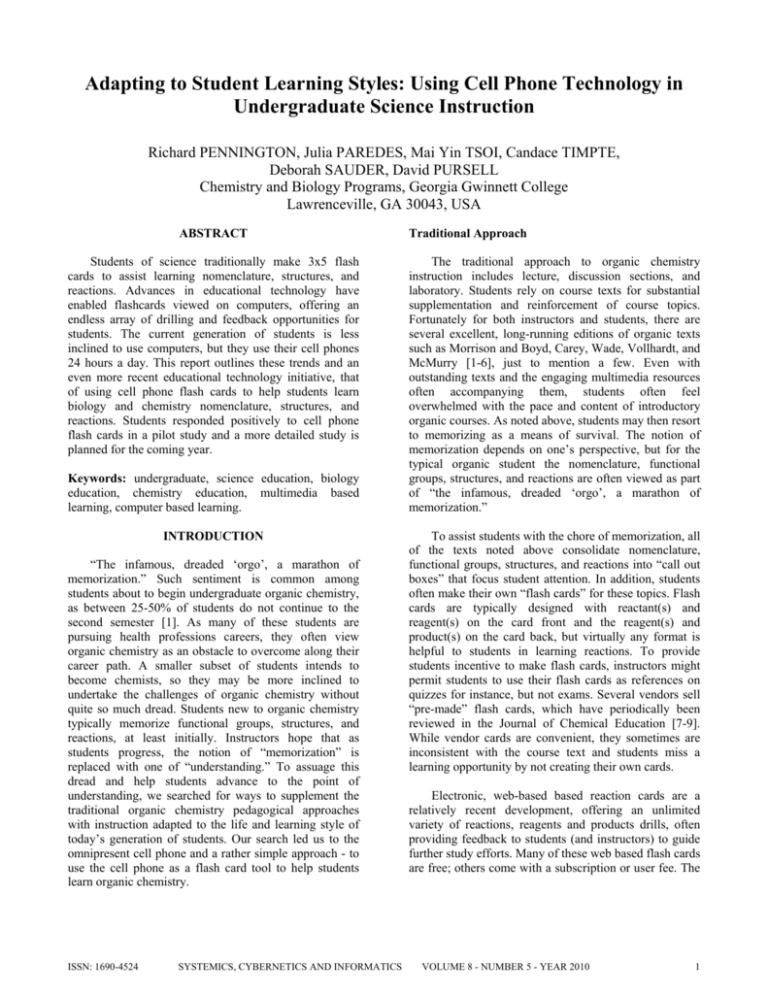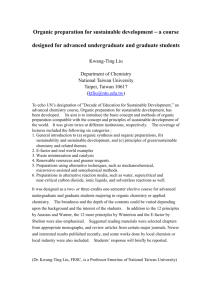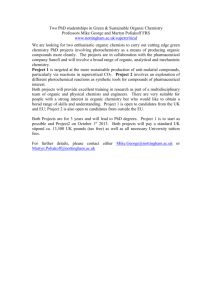
Adapting to Student Learning Styles: Using Cell Phone Technology in
Undergraduate Science Instruction
Richard PENNINGTON, Julia PAREDES, Mai Yin TSOI, Candace TIMPTE,
Deborah SAUDER, David PURSELL
Chemistry and Biology Programs, Georgia Gwinnett College
Lawrenceville, GA 30043, USA
ABSTRACT
Students of science traditionally make 3x5 flash
cards to assist learning nomenclature, structures, and
reactions. Advances in educational technology have
enabled flashcards viewed on computers, offering an
endless array of drilling and feedback opportunities for
students. The current generation of students is less
inclined to use computers, but they use their cell phones
24 hours a day. This report outlines these trends and an
even more recent educational technology initiative, that
of using cell phone flash cards to help students learn
biology and chemistry nomenclature, structures, and
reactions. Students responded positively to cell phone
flash cards in a pilot study and a more detailed study is
planned for the coming year.
Keywords: undergraduate, science education, biology
education, chemistry education, multimedia based
learning, computer based learning.
INTRODUCTION
“The infamous, dreaded ‘orgo’, a marathon of
memorization.” Such sentiment is common among
students about to begin undergraduate organic chemistry,
as between 25-50% of students do not continue to the
second semester [1]. As many of these students are
pursuing health professions careers, they often view
organic chemistry as an obstacle to overcome along their
career path. A smaller subset of students intends to
become chemists, so they may be more inclined to
undertake the challenges of organic chemistry without
quite so much dread. Students new to organic chemistry
typically memorize functional groups, structures, and
reactions, at least initially. Instructors hope that as
students progress, the notion of “memorization” is
replaced with one of “understanding.” To assuage this
dread and help students advance to the point of
understanding, we searched for ways to supplement the
traditional organic chemistry pedagogical approaches
with instruction adapted to the life and learning style of
today’s generation of students. Our search led us to the
omnipresent cell phone and a rather simple approach - to
use the cell phone as a flash card tool to help students
learn organic chemistry.
ISSN: 1690-4524
SYSTEMICS, CYBERNETICS AND INFORMATICS
Traditional Approach
The traditional approach to organic chemistry
instruction includes lecture, discussion sections, and
laboratory. Students rely on course texts for substantial
supplementation and reinforcement of course topics.
Fortunately for both instructors and students, there are
several excellent, long-running editions of organic texts
such as Morrison and Boyd, Carey, Wade, Vollhardt, and
McMurry [1-6], just to mention a few. Even with
outstanding texts and the engaging multimedia resources
often accompanying them, students often feel
overwhelmed with the pace and content of introductory
organic courses. As noted above, students may then resort
to memorizing as a means of survival. The notion of
memorization depends on one’s perspective, but for the
typical organic student the nomenclature, functional
groups, structures, and reactions are often viewed as part
of “the infamous, dreaded ‘orgo’, a marathon of
memorization.”
To assist students with the chore of memorization, all
of the texts noted above consolidate nomenclature,
functional groups, structures, and reactions into “call out
boxes” that focus student attention. In addition, students
often make their own “flash cards” for these topics. Flash
cards are typically designed with reactant(s) and
reagent(s) on the card front and the reagent(s) and
product(s) on the card back, but virtually any format is
helpful to students in learning reactions. To provide
students incentive to make flash cards, instructors might
permit students to use their flash cards as references on
quizzes for instance, but not exams. Several vendors sell
“pre-made” flash cards, which have periodically been
reviewed in the Journal of Chemical Education [7-9].
While vendor cards are convenient, they sometimes are
inconsistent with the course text and students miss a
learning opportunity by not creating their own cards.
Electronic, web-based based reaction cards are a
relatively recent development, offering an unlimited
variety of reactions, reagents and products drills, often
providing feedback to students (and instructors) to guide
further study efforts. Many of these web based flash cards
are free; others come with a subscription or user fee. The
VOLUME 8 - NUMBER 5 - YEAR 2010
1
web based reaction flash cards have been shown effective
in enhancing student ability to learn reactions [10-15].
New Educational Technology Approach
Younger generations of students are trending away
from computer use, as desktops, and even laptops, are
considered too unwieldy and location-centric and thus
inconvenient. The Pew Internet project notes that 62% of
all Americans are part of a wireless, mobile population
that participates in digital activities away from home or
work, 58% of adult Americans have used a cell phone or
PDA to do non-voice activities, and 41% of adult
Americans have logged onto the internet on the go via
wireless laptop or handheld device [16]. The Chronicle of
Higher Education and the Guardian recently reported the
sentiment that email [and by extension the computer] is
for old people as students “live and die by their cell
phones” [17, 18]. As an indication of how the younger
generation is using new media tools, the UCSD Organic
Chemistry program was recently featured in a
Physorg.com article titled “Organic Chemistry for the
YouTube Generation” in which students perform organic
techniques, pre-lab briefings, and demonstrations in short
audio-video clips [19]. With the advent of the iPhone and
other handheld devices, students can access this organic
course content 24 hours a day. This 24 hour a day access
is likewise available with “podcasts” that are appearing in
instructional efforts in many disciplines [20].
As students migrate to the versatility, mobility, and
convenience of cell phones---they can listen to music,
watch videos, text or call friends, email, surf the web,
play games---all on a pocket size device, the previous
allure of the laptop computer is rapidly waning. A
challenge for educators is to capitalize on the pervasive
use of cell phones by younger students. Cell phones will
soon be commonly available with full-scope projection
systems, full-size keyboards made of light, and speed and
memory suitable for a wide variety of multi-tasking
activities [21]. The BBC News recently explored the
potential move away from laptop computers by
conceiving of “an international network of wirelesslyconnected computers throughout the developing world”
via handheld cell phones and devices. “The question we
should be asking ourselves, then, is not ‘how can we buy,
and support, and supply electricity for, a laptop for
everyone,’ but rather ‘what mobile software can we write
that would really add value for everyone and that could
run on the computer they already have in their pocket?”
[22]
There have been recent initiatives designed to
capitalize on the capabilities of cell phones to enhance
education. Liz Kolb discuses many approaches to
integrating cell phones into the classroom, primarily in
the K-12 environment [23]. Professor Michal
Yerushalmy, of the University of Haifa, Israel has
2
SYSTEMICS, CYBERNETICS AND INFORMATICS
developed five “Math4Mobile” applications that help
students intuitively learn about mathematical concepts
using their cell phone [24, 25]. Her approach is focused
on the high school level, but has the potential for use with
college level courses and tutorials. Taken perhaps to the
extreme, Mobile Enterprise reports that Colorado
Technical University has launched CTU Mobile, which is
a virtual campus and curriculum away from student’s
computers where they can view assignments, grades,
administrative information, video coursework, and
podcasts on their cell phones [26, 27].
Concerns with using cell phones as educational
technology includes student disruption and inattention
during class and increased opportunity for cheating. The
Journal of Chemical Education has had a long running
series on “Crime in the Classroom”, noting that “because
exams often determine the future of those taking them, it
is inevitable that cheating will be a strong temptation for
many students [28-31]. With cell phones, students may
send photos and text messages back and forth of their
solutions, ranging from detailed problem set ups to
multiple choice answers. With phone distribution lists,
these messages could be sent throughout the section in
just one message [32]. Therefore, using cell phones as
educational technology should address these concerns.
Organic Chemistry Cell Phone Flash Cards
With these trends in mind, the logical progression of
organic flash cards is from 3x5 paper cards, to web based
electronic flash cards, to cell phone viewable flash cards.
To this end, during the past year, we developed organic
chemistry flash cards viewable on a cell phone with
Mobile PowerPoint. The flash cards covered topics new
students tend to initially memorize (functional groups,
structures, and reactions) before they have worked with
them sufficiently to become second nature. The approach
was to engage students with a tool of their generation, the
cell phone. The intent was that students could flip
through their cell phone flash cards while waiting in line
at the movies, riding as a passenger in a car, hanging out
with their friends—most anywhere without feeling “out
of the communication loop” when the alternative might
be to pull out a stack of 3x5 flash cards, power up their
laptop, or not study their functional groups, structures,
and reactions at all. This is not to say they were not
engaged with traditional tools—text books, solutions
manuals, molecular model kits, etc. Students were
provided a mix of the traditional and the new, resulting in
study tools that were useful, always with them, and that
they might find “cool” to use.
The cell phone flash cards were organized by text
chapter (Figure 1) to help students stay in sync with the
course syllabus. The format of the cards was flexible,
with examples shown below for functional groups
(Figure 2), structures (Figure 3), and reactions (Figure 4).
VOLUME 8 - NUMBER 5 - YEAR 2010
ISSN: 1690-4524
As not all students had cell phones suitable for flash
cards, they were also encouraged to make the traditional
paper 3x5 flash cards. Students were encouraged to use
either their cell phone or 3x5 flash cards during
homework, in class problem solving sessions, and during
laboratory sessions. The flash cards were not permitted
during exams.
Figure 3. Example of “front” (left) and “back” (right) of a
structure flash card.
Figure 1. Organic chemistry flash card table of contents,
organized by text chapter
Figure 4. Example of “front” (left) and “back” (right) of a
reaction flash card.
CONCLUSIONS
Figure 2. Example of “front” (left) and “back” (right) of a
functional group flash card.
ISSN: 1690-4524
SYSTEMICS, CYBERNETICS AND INFORMATICS
Students responded favorably to the introduction of
cell phone flash cards. A Likert scale survey (Table 1)
captured student attitude about the organic chemistry cell
phone flash cards. In general, student attitudes were very
positive. Students universally believed learning organic
reactions is an important part of organic chemistry and
the cell phone flash cards helped enable them to do so.
Students especially appreciated that cell phones are
VOLUME 8 - NUMBER 5 - YEAR 2010
3
always with them, so they may study the material any
time, any place.
Respond to the statements
using the scale below:
[5] Strongly Agree; [4] Agree
[3] Neutral; [2] Disagree
[1] Strongly Disagree
1. Learning organic reactions
is important to learning
organic chemistry.
2. I find learning organic
reactions challenging.
3. Learning organic reactions
is critical to the higher
level task of doing organic
synthesis.
4. Studying my course notes
enables me to learn organic
reactions.
5. Studying the text enables
me to learn organic
reactions.
6. Studying “paper reaction
flash cards” enables me to
learn organic reactions.
7. Studying “cell phone
reaction flash cards”
enables me to learn organic
reactions.
8. “Cell phone” based
learning tools are valuable
because I always have my
cell phone with me but I do
not always have my
computer, texts, notes, and
other learning
methodologies with me.
9. I am concerned that
students might attempt to
“cheat” on exams by using
their cell phones.
10. I am confident my
instructor can prevent
student cell phone
“cheating” on exams.
Ave
Std
Dev
5.0
0.00
4.5
0.58
5.0
0.00
4.0
0.82
cheating via their cell phones. With the positive initial
reception of cell phone flash cards in organic chemistry,
the use of these flash cards will be expanded during the
coming year to include not only organic chemistry, but
also the following courses: general chemistry, where
students must learn topics such as polyatomic ion
nomenclature and molecular structure; introductory
biology, where students must learn which monomers
comprise macromolecules and the functions of the
macromolecules and stepwise processes such as DNA
replication; biochemistry, where students must learn the
names and structures of the 20 common amino acids and
the steps of intermediary metabolic pathways.
The expanded study will include attitudinal surveys
of students and faculty and also investigate how
performance on graded events covering topics such as
organic reactions might be related to student cell phone
flash card use.
REFERENCES
3.8
1.50
[1] Zurer, P. S. Chem. Engr. News 2001, 79 (16), 42-43.
3.3
0.96
[2] Morrison, R. T.; Boyd, R. N. Organic Chemistry,
6th ed.; Prentice Hall: New York, NY; 1992.
0.82
[3] Carey, F. A. Organic Chemistry, 7th ed.; McGrawHill: New York, NY; 2008.
4.0
[4] Wade, L. G., Jr. Organic Chemistry, 6th ed.;
Pearson Prentice Hall: Upper Saddle River, NJ; 2006.
5.0
0.00
[5] Vollhardt, K. P. C.: Schore, N. E. Organic
Chemistry 5th ed.; W. H. Freeman: New York, NY;
2007.
[6] McMurry, J. Organic Chemistry, 7th ed.; Brooks
Cole: Belmont, CA; 2007.
2.0
1.00
[7] Gooch, E. J. Chem. Educ. 2003, 80, 1009-1010.
[8] Baltzer, B. L. Organic Chemistry Flash Cards;
Bryan Edwards Publishing: Orange, CA; 1994.
4.0
2.00
Table 1. Organic chemistry cell phone flash card student
survey
[9] Wang, S. Q.; Ranzani, B.; Lee, E. J. K.; Wu, J.;
Berkowitz, W. OrgoCards: Organic Chemistry
Review; Barron’s Educational Series: Hauppauge,
NY; 2005.
[10] Mahan, E. J. Chem. Educ. 2006, 83, 672.
Faculty and administrators are often concerned about
cell phones facilitating cheating. For students, cell phone
cheating was not a significant concern and they felt
confident that instructors could prevent such cheating.
With effective controls during graded events, it is
reasonable that instructors may prevent students from
4
SYSTEMICS, CYBERNETICS AND INFORMATICS
[11] Mahan, E. JCE WebWare. The Reaction Rolodex: A
Web-Based System for Learning Reactions in
Organic Chemistry, 2006.
http://www.JCE.DivCHED.org/JCEDLib/WebWare/
. (accessed July 2008).
VOLUME 8 - NUMBER 5 - YEAR 2010
ISSN: 1690-4524
[12] Mahan, E. The Reaction Rolodex. Department of
Chemistry, Hartford University, 2003.
http://uhaweb.hartford.edu/chemistry/ch230/reaction
s/. (accessed July 2008).
[13] Lowary, T.; Hadad, C.; Parker, S.; McCarren, P.;
Feng, J. A.; “Electronic Flash Cards: An Educational
Resource for Students in Organic Chemistry.”
Department of Chemistry, The Ohio State
University. http://www.chemistry.ohiostate.edu/organic/flashcards/. (accessed July 2008).
[14] Poon T. OCHeM.com: Electronic Resources for
Organic Chemistry Students since 1999. The Joint
Science department of Claremont McKenna, Pitzer,
and Scripps Colleges. http://www.ochem.com/.
(accessed July 2008).
[15] Flashcard Exchange. Chemistry-Organic Reactions.
http://www.flashcardexchange.com/flashcards/view/
275317/. (accessed July 2008.
[16] Pew Internet and American Life Project Reports.
Technology and Media Use.
http://www.pewinternet.org/topics.asp?c=4.
(accessed July 2008).
[17] Carnevale, D. The Chronicle of Higher Education,
“E-Mail is for Old People,” October 6,
2006.
http://chronicle.com/free/v53/i07/07a02701.htm.
(accessed July 2008)
[18] Fitzpatrick, M. The Guardian, “Digital Generation
Dismisses Email as ‘for old people’,” December 6,
2007.
http://www.guardian.co.uk/technology/2007/dec/06/
digitalcommunication. (accessed July 2008).
[19] Physorg.com, “Organic Chemistry for the YouTube
Generation,” December 6, 2007.
http://www.physorg.com/news116181206.html.
(Accessed July 2008).
[23] Kolb, L. Toys to Tools: Connecting Student Cell
Phones to Education; International Society of
Technology in Education, October 2008.
[24] Science Daily, “Mobile Math Lab for Cell Phones,”
July 12, 2007.
http://www.sciencedaily.com/releases/2007/07/0707
11001517.htm. (accessed July 2008).
[25] Yerushalmy, M. Math4Mobile. Department of
Mathematics Education, University of Haifa, Israel.
http://www.math4mobile.com/. (accessed July 2008).
[26] Mobile Enterprise, “Colorado Online University
Offers Education via Cell Phone,” October 8, 2007.
http://www.mobileenterprisemag.com/ME2/dirmod.a
sp?sid=&nm=News&type=news&mod=News&mid=
9A02E3B96F2A415ABC72CB5F516B4C10&tier=3
&nid=B8E7025703EB47EBA77C099C507827E4.
(accessed July 2008)
[27] Colorado Technical University Online.
http://www.ctuonline.edu/. (accessed July 2008).
[28] Harpp, D. N. J. Chem. Educ. 2008, 85, 805-806.
[29] Harpp, D. N; Hogan, J. J. J. Chem. Educ. 1998, 75,
482-483.
[30] Harpp, D. N; Hogan, J. J.; Jennings, J. S. J. Chem.
Educ. 1996, 73, 349-351.
[31] Harpp, D. N; Hogan, J. J. J. Chem. Educ. 1993, 70,
482-483.
[32] Van Slack, J. The Patriot Ledger, “Cheating Keeps
Getting Easier: Students using Cell Phones to Cheat
on Exams,” Tuesday, August 28, 2007.
http://ledger.southofboston.com/articles/2004/06/14/
news/news01.txt (accessed July 2008).
[20] Rampell, C. The Chronicle of Higher Education, “A
Professor of Pediatrics Uses Technology to Enliven
Bacteriology,” 54 (41), A9, June 20, 2008.
[21] 2007 Horizon Report. Two to Three Years: Mobile
Phones. January 23, 2007.
http://www.nmc.org/horizonproject/2007/mobilephones. (Accessed July 2008).
[22] Selanikio, J. BBC News, “The Invisible Computer
Revolution,” January 17, 2008.
http://news.bbc.co.uk/1/hi/technology/7106998.stm.
(accessed July 2008).
ISSN: 1690-4524
SYSTEMICS, CYBERNETICS AND INFORMATICS
VOLUME 8 - NUMBER 5 - YEAR 2010
5





